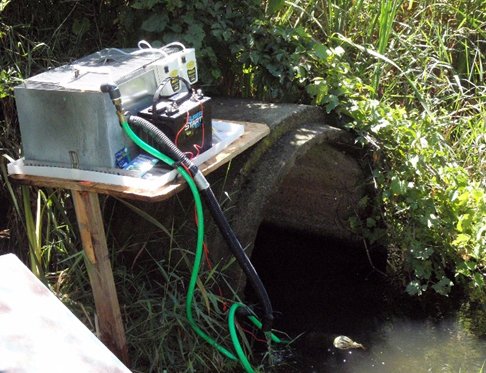Flow-through units being deployed along L.A. River to study CECs’ impacts on fish

SCCWRP and its partners will expose fish to flowing Los Angeles River water in real time this spring as part of an on-site study examining potential biological impacts to fish from exposure to contaminants of emerging concern (CECs).
The pilot project, which marks the first use of mobile exposure units for a Southern California water-quality study, will enable researchers to replicate environmental conditions more accurately than exposing the fish to a water sample in a laboratory setting. Mobile exposure units are set up along stream banks to pump water in real time through fish exposure chambers; the devices control for factors such as flow rate, food source, illumination and dissolved oxygen.
For the pilot study, scheduled to kick off in April, SCCWRP and the City of Los Angeles Bureau of Sanitation will set up mobile exposure units at two L.A. River sites – one just downstream of the L.A.-Glendale Water Reclamation Plant, and the other at a site in the Sepulveda Basin that receives urban runoff. Fathead minnows will be placed in exposure chambers for 15 days.
Researchers hope to learn whether CECs, which can be found in wastewater effluent and land-based runoff, trigger biological effects in fish, including changes in gene expression, tissue integrity and sex characteristics.
SCCWRP will analyze the fish using traditional toxicology tests and targeted chemical analysis, as well as use novel bioanalytical assays to link observed biological effects to CEC bioactivity levels.
In particular, endocrine-disruptive CECs such as nonylphenol, estrone, bisphenol A and galaxolide have been shown to affect sexual maturation and reproduction of fish in laboratory settings; these CECs have previously been detected in the L.A. River watershed.
The L.A. River flow-through study is being launched as water-quality regulators increasingly focus on understanding how CECs in freshwater systems could be affecting fish communities.
Over time, SCCWRP intends to use the mobile exposure units to conduct additional exposure studies in other watersheds. The goal is to gain a better understanding of what biological endpoints should be tracked to comprehensively assess CECs’ impacts on fish.
For more information, contact Dr. Alvina Mehinto.
More news related to: Bioanalytical Cell Screening Assays, Emerging Contaminants, Top News